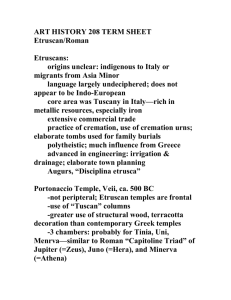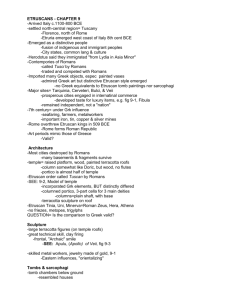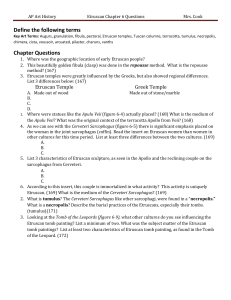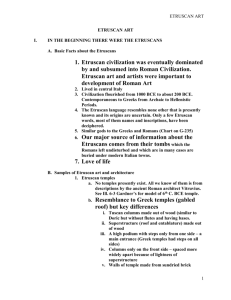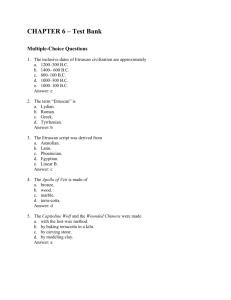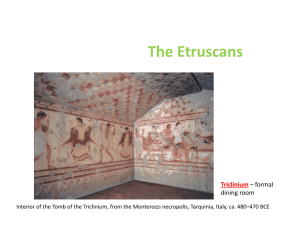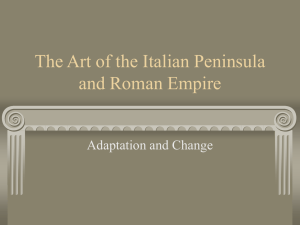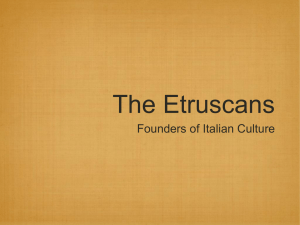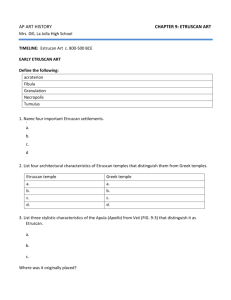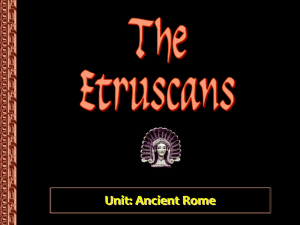Etruscan Art
advertisement
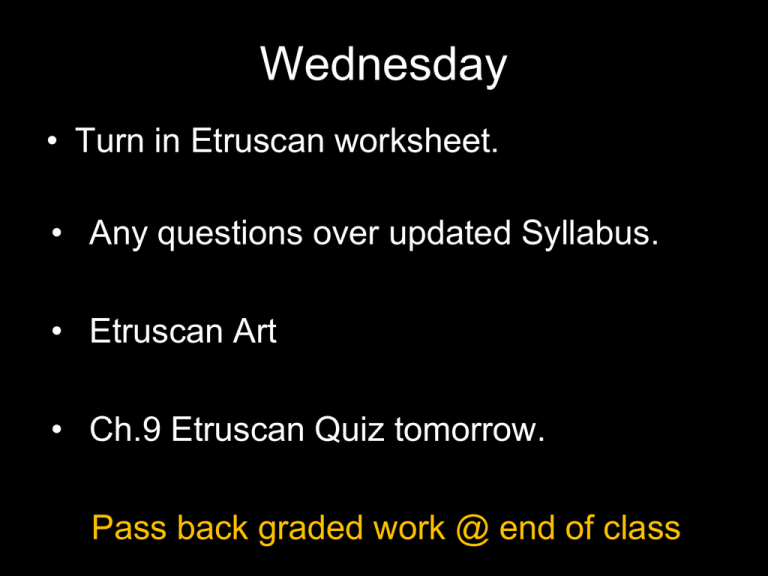
Wednesday • Turn in Etruscan worksheet. • Any questions over updated Syllabus. • Etruscan Art • Ch.9 Etruscan Quiz tomorrow. Pass back graded work @ end of class 9/28/11 Reading Prompt • In what way was the Etruscan rise and fall from power reflected in the decoration of their tombs? To what degree was it reflected in their bronze work? • Write & Date Question. Highlight answer in your lecture notebook. Will grade answer when I collect your notes on Unit 2 exam day. Divide into groups of 3 • Each group will have an artwork to Analyze in 5 minutes. • Will share analysis to the class. (15 min) minutes) • Write on white boards. Big/ Clear/ Precise – Everyone else takes notes. • Form-Describe the form, elements & principles of design. How it looks. Shape, lines, style, colors, etc. • Content- What do you see? What is depicted • Context- What is the function? Context – Context answers: • 1.“What is the ART for & what does the ART do?” Artworks 1. 2. 3. 4. Etruscan Temple Reclining Couple Sarcophagus Tomb of the Leopards Capitoline Wolf Monday • Aegean & Greek Quiz (15 minutes) • Etruscan P.P. • Reminder: – Roman worksheets due Tomorrow – Thursday Rough Draft Essay & Bibliography DUE!!! – Extra Credit: During A Lunch, or after school Today, come in to watch Art of the Western World episode: Greek Art. Attending this session, for at least 30 minutes, will earn you a 100 to substitute for a missing or low quiz grade. Lunch session (must be here on time! Will not get credit if you’re working on homework or goofing off) Etruscan Art (700-539 BCE) • Etruscans = Ancient Italians who adopted much of he Greek Culture (was ETRURIA, now TUSCANY) • We know about their culture from the elaborate Necropoli filled with tombs • Sculptures influence by Archaic Greek work • Bronze and Terra-cotta works Etruscan Art (700-539 BCE) Columns were smooth and did not surround temple Only one set of stairs leading up to stylobate Lots of terra-cotta sculpture – especially on roof Front and Back sides no longer the same Kroisos Anavysos, Greece ca. 530 BC Apulu (Apollo) from the roof of the Portonaccio Temple (Veii), c. 510-500 BCE, painted terracotta Apulu (Apollo) from the roof of the Portonaccio Temple (Veii), c. 510-500 BCE, painted terracotta Etruscan temples with rooftop terracotta statuary, three cellas, Tuscan columns, and a frontal staircase/ animated figures with an “Archaic smile”/ Apulu (Etruscan Apollo), possibly the work of Vulca of Veii Left: Reconstruction of an Etruscan temple (Veii), c. 510-500 BCE, painted terracotta Right: Apulu (Apollo) from the roof of the Portonaccio Temple Etruscan tombs (tumuli) carved out of tufa The tombs of Cerveteri Orientalizing lions from the Regolini-Galassi Tomb (Cerveteri), c. 650-640 BCE fibula, a fastening pin found in a tomb/ combining repoussé with granulation/ Eastern influences (Orientalizing lions) Sarcophagus from Cerveteri. C520 BCE 6’7” in length. ETRUSCAN Sarcophagus of Ramtha Visnai (Vulci), c. 300 BCE, limestone Tomb of the Reliefs (Cerveteri), 3rd century BCE musici ans from the Tomb of the Leopa rds (Tarqu inia), Musicians from the Tomb of the Leopards (Tarquinia), c. 480-470 BCE Tomb of the Leopards (Tarquinia ), c. 480470 BCE Romulus and Remus nursed by a She-Wolf Tarquinius Superbus, the last of the Etruscan kings/ Romulus and Remus (placed on a raft by their mother Rhea Silvia to protect them from the rage of their uncle Amulius) raised by a she-wolf/ mixture of stylization and naturalism, with incised detail Chimera of Arezzo (Arezzo), early 4th century BCE, bronze a chimera: ( mythical monster-lion head, lion tail) depicted as a composite animal, animated and ferocious/ killed by Bellerophon while riding Pegasus Mars of Todi, early 4th century BCE, bronze Etruscan interpretation of the Polykleitan canon/ rarity of nudity in Etruscan art Novios Plautios. Ficoroni Cista (Palestrina), late 4th century BCE, Cista-cylindrical containers used by wealth women. Aule Metele (Arringatore, Orator) (Sanguineto), early 1st century BCE self-confidence of a Roman magistrate with an Etruscan name/ resemblance to contemporary Roman portraits and inspiration for later depictions of emperors (such as Augustus)
